-
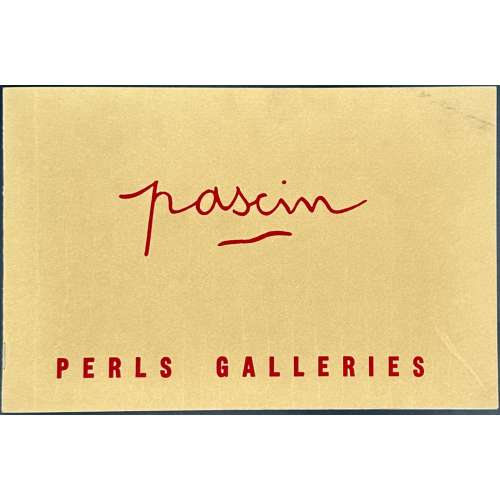 NEWFour exhibition catalogues at Perls Galleries in NYC, coloured stiff laid paper wrappers, colour lettering, staples, b/w plates: September 22 - October 25, 1952, 8 pp; November 14 - December 24, 1955, 12 pp.; “The Nude” January 5 - February 7, 1959. 16 pp.; Portraits and Models November 20 - December 29, 1962, 12 pp. Size: 155 x 240 mm each.
NEWFour exhibition catalogues at Perls Galleries in NYC, coloured stiff laid paper wrappers, colour lettering, staples, b/w plates: September 22 - October 25, 1952, 8 pp; November 14 - December 24, 1955, 12 pp.; “The Nude” January 5 - February 7, 1959. 16 pp.; Portraits and Models November 20 - December 29, 1962, 12 pp. Size: 155 x 240 mm each. -
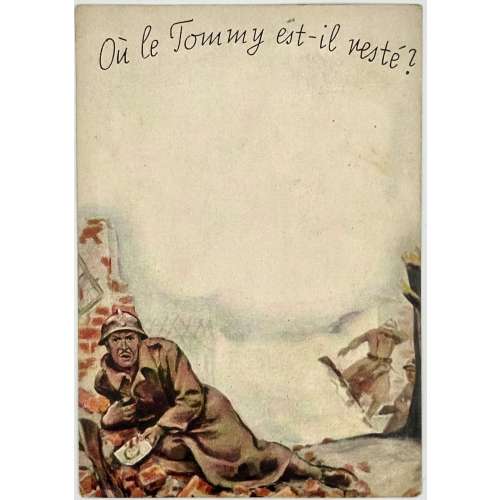 NEWOne of a series of six anti-allies propaganda cards, printed in colour, inscribed Ou le Tommy est-il resté? (Where did Tommy stay?), where Tommy is slang for a common soldier in the British Army. The postcards visibly depict French soldiers who fight and die at the western front, while the covert watermark image shows a British military having fun in a bordello. Those cards were printed in the Third Reich for France and dropped from aeroplanes to motivate French soldiers to fight against the British. Size: 149 x 104 mm
NEWOne of a series of six anti-allies propaganda cards, printed in colour, inscribed Ou le Tommy est-il resté? (Where did Tommy stay?), where Tommy is slang for a common soldier in the British Army. The postcards visibly depict French soldiers who fight and die at the western front, while the covert watermark image shows a British military having fun in a bordello. Those cards were printed in the Third Reich for France and dropped from aeroplanes to motivate French soldiers to fight against the British. Size: 149 x 104 mm -
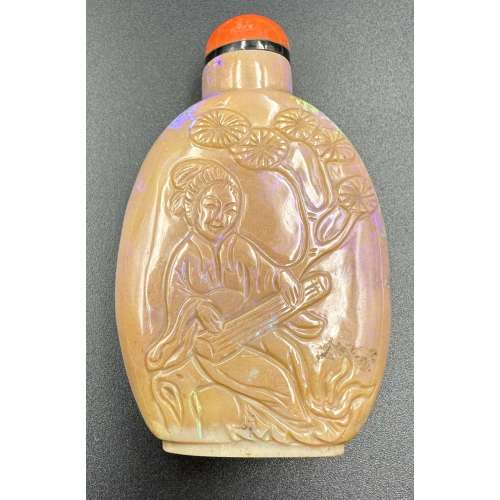 NEWOpal jasper snuff bottle carved in low relief with a beauty playing Guqin under a pine tree and another on the veranda with a folding fan; bamboo, pine, and plum (the three friends of winter); carnelian agate stopper and black collar. Mid-20th century Dimensions: H67 x W41 x D15 mm
NEWOpal jasper snuff bottle carved in low relief with a beauty playing Guqin under a pine tree and another on the veranda with a folding fan; bamboo, pine, and plum (the three friends of winter); carnelian agate stopper and black collar. Mid-20th century Dimensions: H67 x W41 x D15 mm -
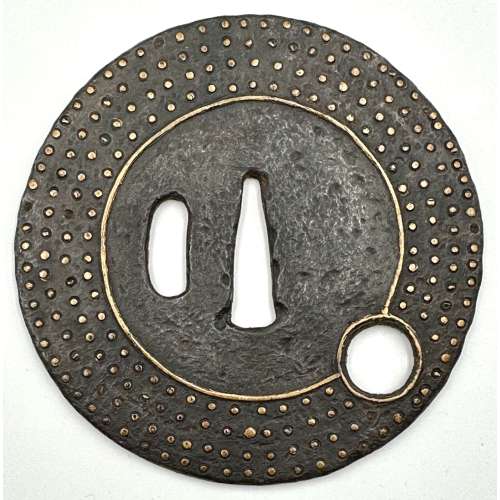 NEW
NEWIron tsuba of round form with one hitsu ana; centre of the plate outlined with the inlaid circular brass wire broke by a circular opening 7 mm in diameter located between 4 and 5 o’clock of the plate and in its turn outlined with brass wire. Extraneous to the central wire, the plate is decorated with four rows of brass dots (ten-zogan). A few dots are missing. In a custom kiri wood box. The meaning of the emblem is probably either the sun or the moon.
Ōnin school. Unsigned.
Mid Muromachi period, middle of the 15th century.
Dimensions: diameter 88 mm; thickness 3.3 mm.
-
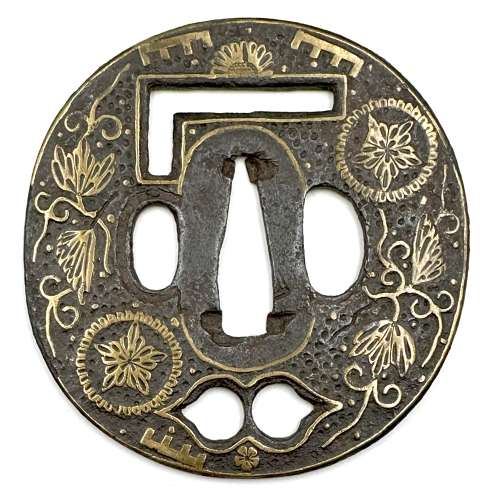 NEWIron tsuba of slightly elongated round form (nagamaru-gata) pierced on top and in the bottom (ko-sukashi) with simplified Genji-kō (incense game symbol) and two petals of bellflower; openings, seppa-dai, and plate along the rim are outlined with brass wire, kozuka-ana outlined with scalloped brass wire, missing on the front; kogai-ana pierced later. The plate is slightly concave with traces of lacquer, decorated in brass (suemon-zōgan) with tendrils, bellflowers, and Genji characters, and with brass dots (ten-zogan), many of which are missing. Measurements: Height 77.5 mm; Width 75.5 mm; thickness at seppa-dai 2.4 mm, at rim 3.2 mm. Time: Late Muromachi (1514 – 1573) or earlier.
NEWIron tsuba of slightly elongated round form (nagamaru-gata) pierced on top and in the bottom (ko-sukashi) with simplified Genji-kō (incense game symbol) and two petals of bellflower; openings, seppa-dai, and plate along the rim are outlined with brass wire, kozuka-ana outlined with scalloped brass wire, missing on the front; kogai-ana pierced later. The plate is slightly concave with traces of lacquer, decorated in brass (suemon-zōgan) with tendrils, bellflowers, and Genji characters, and with brass dots (ten-zogan), many of which are missing. Measurements: Height 77.5 mm; Width 75.5 mm; thickness at seppa-dai 2.4 mm, at rim 3.2 mm. Time: Late Muromachi (1514 – 1573) or earlier. -
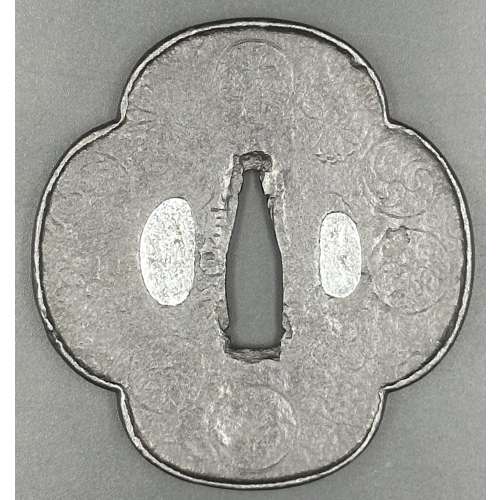 Iron tsuba of mokko form decorated with encircled family crests in low relief carving; niku from 3.0 mm in the centre to 4.0 mm at rim and full 1 mm raised uchikaeshi-mimi. Nobuie [信家] signature (hanare-mei) to the left of nakago-ana; on the reverse, to the right of nakago-ana, the inscription reads “62”, which may be how old the master was at the age of making the tsuba. Pewter or lead plugged hitsuana. In a wooden box, in a custom pouch. Size: H: 80 mm, W: 75, Th(c): 3.1 mm, Th(r): 4.0 mm Weight: 103.5 g
Iron tsuba of mokko form decorated with encircled family crests in low relief carving; niku from 3.0 mm in the centre to 4.0 mm at rim and full 1 mm raised uchikaeshi-mimi. Nobuie [信家] signature (hanare-mei) to the left of nakago-ana; on the reverse, to the right of nakago-ana, the inscription reads “62”, which may be how old the master was at the age of making the tsuba. Pewter or lead plugged hitsuana. In a wooden box, in a custom pouch. Size: H: 80 mm, W: 75, Th(c): 3.1 mm, Th(r): 4.0 mm Weight: 103.5 gSigned: Nobuie [信家] / 62
Probably the work of Shodai Nobuie (c. 1580).
Tokubetsu hozon certificate № 2002993 of the N.B.T.H.K., dated January 15, 2016. NOBUIE TSUBA by Steve Waszak The iron tsuba made by the two early Nobuie masters are regarded as the greatest sword guards ever made across hundreds of years of Japanese history. Only a small handful of other smiths' names are even mentioned in the same breath as that of Nobuie. Despite the well-deserved fame of the Nobuie name, virtually nothing is known with certainty about the lives of the two men who made the pieces carrying this name. They are thought to have been men of Owari Province, with the Nidai Nobuie also spending time in Aki Province at the end of the Momoyama Period. Two Nobuie tsubako are recognized. The man whom most consider to have been the Shodai signed his sword guards with finer and more elegantly inscribed characters than the smith seen by most as the Nidai. The term used to describe the mei of the Shodai is "hanare-mei" or "ga-mei," while that used to characterize the signature of the Nidai is "futoji-mei" or "chikara-mei." These terms refer to the fineness and grace of the Shodai's signature and the relatively more powerfully inscribed characters of the Nidai's. The Shodai is thought to have lived during the Eiroku and Tensho eras in the latter part of the 16th century, while the Nidai's years are considered to have been from Tensho into the Genna era. This locates both smiths well within the Golden Age of tsuba artists -- the Momoyama Period. Nobuie tsuba are esteemed and celebrated for the extraordinary beauty of their iron. The combination of the forging of the metal, the surface treatment by tsuchime and yakite married to powerfully expressive carving, the masterful manipulation of form, mass and shape, and the colour and patina of the iron makes Nobuie sword guards not only unique in the world of tsuba, but the greatest of the great. The sword guard here is a Shodai-made masterwork, done in mokko-gata form, a shape the early Nobuie smiths mastered to a degree unmatched by any others. The expanding of the mass of the tsuba from the seppa-dai to the mimi, increasing by 50% from the centre of the guard to the rim, creates a sense of exploding energy, which is then contained by the uchikaeshi-mimi, yielding a lightning-in-a-bottle effect of captured energy. The hammering the master has employed to finish the surface is subtle and sensitive, achieving a resonant profundity, and the deep blue-black colour -- augmented by a lustrous patina -- leaves the tsuba to positively glow in one's hand. In this piece, Nobuie has used a motif of several kamon, or family crests, each carved only lightly on the surface in a loose ring around the nakago-ana. Due to the shallow depth of this carving, together with the tsuchime finish of the plate, the effect is to leave the kamon with a sort of weathered appearance, recalling the prime aesthetic values of sabi and wabi, which had great circulation in the Tea Culture so ascendant in the Momoyama years. However, the effects of sabi and wabi expressed in the treatment described above are amplified and deepened by the color and patina of the iron, thereby adding yet another aesthetic value -- yuugen -- which is linked with the abiding mystery of the universe and one more — mono no aware — which alludes to the pathos of life's experiences and transitory nature. In short, this Nobuie tsuba joins poetry with power and therein exemplifies the unrivalled brilliance of Nobuie workmanship. -
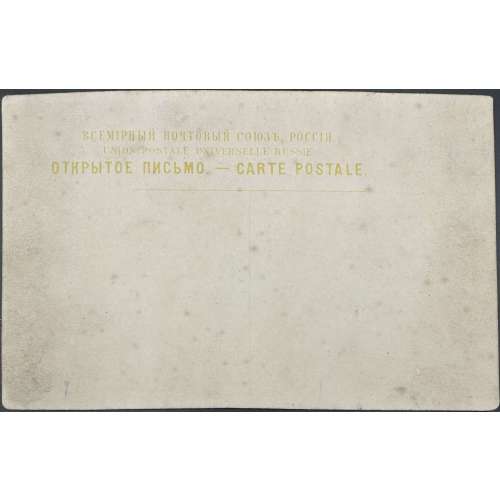 Ten postcards 90 x 140 mm, text in yellow "ВСЕМIРНЫЙ ПОЧТОВЫЙ СОЮЗЪ. РОССIЯ. | UNION POSTALE UNIVERSELLE RUSSIE. | ОТКРЫТОЕ ПИСЬМО. — CARTE POSTALE. || On the reverse, a blue ink woodcut image is printed in the upper left corner, and a blue ink numbered image title is in the bottom centre. Holding the postcard against the backlight reveals a hidden image of an indecent nature (erotic). The use of Latin characters "R" and "N" instead of Russian "Р" and "Н" suggests that the cards were produced in Europe, probably in France. Inscriptions: 1. ПЕRВЫЕ ДNИ; 2. ПОRА ЛЮБВИ; 3. ВЪ ЛЮДИ; 4. КЪ "СВОБОДNОМУ ИСКУССТВУ"; 5. "СВОБОДNЫЙ ТRУДЪ; 6. БЕЗЪ ГОRЯ И ПЕЧАЛИ; 7. NАЗАДЪ КЪ "СВОБОДNОЙ ЛЮБВИ"; 8. ВСЕ ЧТО ОСТАЛОСЬ!; 9. БЕЗЪ КRОВА И ПRИСТАNИЩА; 10. ИЗЪ ЗА ХЛѢБА.
Ten postcards 90 x 140 mm, text in yellow "ВСЕМIРНЫЙ ПОЧТОВЫЙ СОЮЗЪ. РОССIЯ. | UNION POSTALE UNIVERSELLE RUSSIE. | ОТКРЫТОЕ ПИСЬМО. — CARTE POSTALE. || On the reverse, a blue ink woodcut image is printed in the upper left corner, and a blue ink numbered image title is in the bottom centre. Holding the postcard against the backlight reveals a hidden image of an indecent nature (erotic). The use of Latin characters "R" and "N" instead of Russian "Р" and "Н" suggests that the cards were produced in Europe, probably in France. Inscriptions: 1. ПЕRВЫЕ ДNИ; 2. ПОRА ЛЮБВИ; 3. ВЪ ЛЮДИ; 4. КЪ "СВОБОДNОМУ ИСКУССТВУ"; 5. "СВОБОДNЫЙ ТRУДЪ; 6. БЕЗЪ ГОRЯ И ПЕЧАЛИ; 7. NАЗАДЪ КЪ "СВОБОДNОЙ ЛЮБВИ"; 8. ВСЕ ЧТО ОСТАЛОСЬ!; 9. БЕЗЪ КRОВА И ПRИСТАNИЩА; 10. ИЗЪ ЗА ХЛѢБА. -
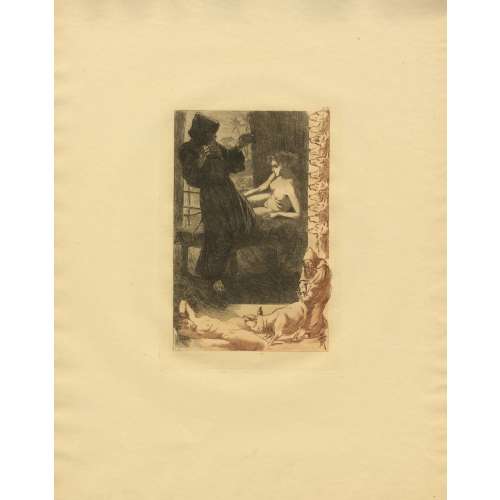 Set of 21 etchings by Martin van Maele for the English edition of ‘Thais’ by Anatole France published in London by Charles Carrington in 1901. Printed on vowe paper without a watermark in two colours with the black image and sepia historiated border. All etchings are inscribed with the artist's monogram; one of the etchings bears inscriptions ORGUEIL, LUXURE, DOUTE (mirror image). Dimensions: sheet: 317 x 250 mm; plate: 170 x 115 mm; image: 155 x 100 mm. Catalogue raisonné: S. A. Perry: № 64. Per Perry, the edition was printed in 500 copies on 'handmade paper watermarked 'Van Gelder'. Contributor: Martin van Maële [Martin, Maurice François Alfred] (French, 1863 – 1926)
Set of 21 etchings by Martin van Maele for the English edition of ‘Thais’ by Anatole France published in London by Charles Carrington in 1901. Printed on vowe paper without a watermark in two colours with the black image and sepia historiated border. All etchings are inscribed with the artist's monogram; one of the etchings bears inscriptions ORGUEIL, LUXURE, DOUTE (mirror image). Dimensions: sheet: 317 x 250 mm; plate: 170 x 115 mm; image: 155 x 100 mm. Catalogue raisonné: S. A. Perry: № 64. Per Perry, the edition was printed in 500 copies on 'handmade paper watermarked 'Van Gelder'. Contributor: Martin van Maële [Martin, Maurice François Alfred] (French, 1863 – 1926) -
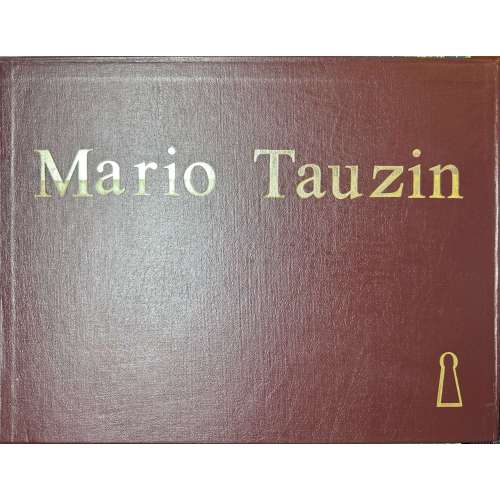 NEWSet of 30 lithographic plates printed on watermarked Van Gelder Simili Japon wove paper, loose in two rexine-backed stiff paper wrappers, 15 in each, together in rexine portfolio with gilt lettering and keyhole on front cover. According to the seller, these are facsimiles of prints/ drawings by Mario Tauzin. Scenes from the series 'Interdit aux adultes'. No publisher indicated; printed in about 1950—a limited edition. Six of these designs used to illustrate 'Bonne à tout faire' were published by Éric Losfeld in the late 1950s (LIB-3293.2024). Dimensions: sheet 320 x 420 mm; album 330 x 430 mm. Contributor: Mario Tauzin (French, 1909 – 1979) — artist
NEWSet of 30 lithographic plates printed on watermarked Van Gelder Simili Japon wove paper, loose in two rexine-backed stiff paper wrappers, 15 in each, together in rexine portfolio with gilt lettering and keyhole on front cover. According to the seller, these are facsimiles of prints/ drawings by Mario Tauzin. Scenes from the series 'Interdit aux adultes'. No publisher indicated; printed in about 1950—a limited edition. Six of these designs used to illustrate 'Bonne à tout faire' were published by Éric Losfeld in the late 1950s (LIB-3293.2024). Dimensions: sheet 320 x 420 mm; album 330 x 430 mm. Contributor: Mario Tauzin (French, 1909 – 1979) — artist -
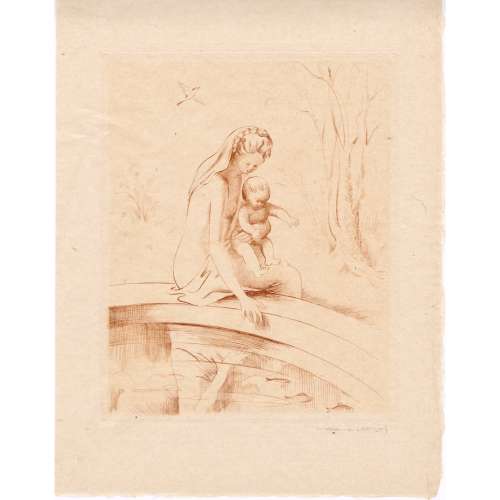 Set of 10 etchings (9 in passe-partout) printed in sanguine on the mother of pearl paper (japon nacre) from the album of 12 prints titled “Jeunesse”, presented by Gérard D'Houville (pen name of Marie de Régnier, née de Heredia) and published by La Tradition in 1945. It was a limited edition of 532 copies, some coloured on Arches paper and some as these set. Plates signed by the artist in pencil below the plate mark. The album cover is missing. Title-page: JEUNESSE | 12 EAUX-FORTES ORIGINALES | DE | MARIANNE CLOUZOT | PRÉSENTÉES | PAR | GÉRARD D'HOUVILLE | {publisher’s device} | LA TRADITION | 1945 || Dimensions: mat 330 x 255 mm; window 225 x 180 mm; sheet 280 x 220 mm; plate 220 x 170 mm. Contributors: Marianne Clouzot (French, 1908 – 2007) – artist Marie de Régnier [Marie de Heredia, Gérard d'Houville] (French, 1875 – 1963) – editor
Set of 10 etchings (9 in passe-partout) printed in sanguine on the mother of pearl paper (japon nacre) from the album of 12 prints titled “Jeunesse”, presented by Gérard D'Houville (pen name of Marie de Régnier, née de Heredia) and published by La Tradition in 1945. It was a limited edition of 532 copies, some coloured on Arches paper and some as these set. Plates signed by the artist in pencil below the plate mark. The album cover is missing. Title-page: JEUNESSE | 12 EAUX-FORTES ORIGINALES | DE | MARIANNE CLOUZOT | PRÉSENTÉES | PAR | GÉRARD D'HOUVILLE | {publisher’s device} | LA TRADITION | 1945 || Dimensions: mat 330 x 255 mm; window 225 x 180 mm; sheet 280 x 220 mm; plate 220 x 170 mm. Contributors: Marianne Clouzot (French, 1908 – 2007) – artist Marie de Régnier [Marie de Heredia, Gérard d'Houville] (French, 1875 – 1963) – editor -
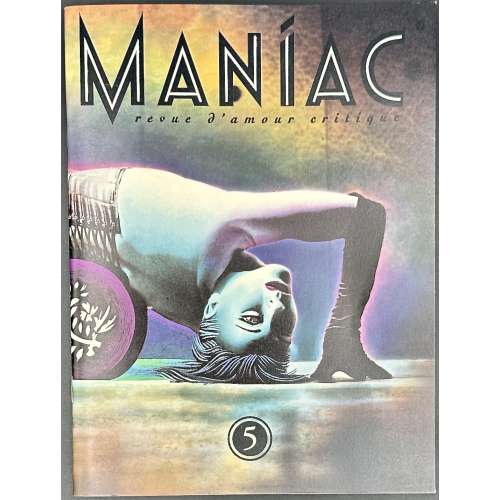 NEWFive issues in publisher's pictorial wrappers, 205 x 155 mm, profusely illustrated French erotic magazines. Published by Éditions Astarté : 58, rue Amelot, 75011 Paris. Rédacteur en chef : Gilles Berquet ; Comité de rédaction : Mïrka Lugosi, Jocelyne and Alexandre Dupouy. Maniac: revue d’amour critique, № 5, octobre 1996, 48p. — Paris: Astarté, 1996 ; ISSN 1261-484X. Maniac: revue d’amour critique, № 6, juin 1997, 48p. — Paris: Astarté, 1996 ; ISSN 1261-484X. Maniac: revue d’amour critique, № 7, octobre 1998, 48p. — Paris: Astarté, 1996 ; ISSN 1261-484X. Maniac: revue d’amour critique, № 8, décembre 2000, 70p (unpag.). — Paris: Astarté, 1996 ; ISSN 1261-484X. Maniac: revue d’amour critique, № 9, janvier 2004, 48p. — Paris: Astarté, 1996 ; ISSN 1261-484X.
NEWFive issues in publisher's pictorial wrappers, 205 x 155 mm, profusely illustrated French erotic magazines. Published by Éditions Astarté : 58, rue Amelot, 75011 Paris. Rédacteur en chef : Gilles Berquet ; Comité de rédaction : Mïrka Lugosi, Jocelyne and Alexandre Dupouy. Maniac: revue d’amour critique, № 5, octobre 1996, 48p. — Paris: Astarté, 1996 ; ISSN 1261-484X. Maniac: revue d’amour critique, № 6, juin 1997, 48p. — Paris: Astarté, 1996 ; ISSN 1261-484X. Maniac: revue d’amour critique, № 7, octobre 1998, 48p. — Paris: Astarté, 1996 ; ISSN 1261-484X. Maniac: revue d’amour critique, № 8, décembre 2000, 70p (unpag.). — Paris: Astarté, 1996 ; ISSN 1261-484X. Maniac: revue d’amour critique, № 9, janvier 2004, 48p. — Paris: Astarté, 1996 ; ISSN 1261-484X. -
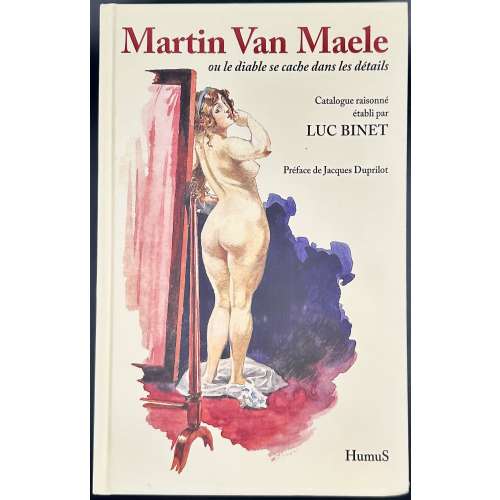 NEWHardcover volume, 292 x 185 x 65 mm, pictorial cream paper over cardboard, black and burgundy lettering to spine and covers; pagination: [4] h.t./imprint, t.p./photo, caption; i-vi, 7-921 [3] colophon; limitation/blank, total 464 leaves. A heavy volume of over 3 kg. Front cover: Martin Van Maele | ou le diable se cache dans détails | Catalogue raisonné | établi par | LUC BINET | Preface de Jacques Duprilot | {vignette} | HumuS || Title-page (red and black): MARTIN VAN MAELE | (1863-1926) | ou le diable se cache dans détails | Catalogue raisonné | établi et commenté par | LUC BINET | Introduction de Jacques Duprilot | {publisher’s device} | ÉDITIONS HUMUS || Edition limited to 333 copies. Maele, Martin van [Martin, Maurice François Alfred] (French, 1863 – 1926)
NEWHardcover volume, 292 x 185 x 65 mm, pictorial cream paper over cardboard, black and burgundy lettering to spine and covers; pagination: [4] h.t./imprint, t.p./photo, caption; i-vi, 7-921 [3] colophon; limitation/blank, total 464 leaves. A heavy volume of over 3 kg. Front cover: Martin Van Maele | ou le diable se cache dans détails | Catalogue raisonné | établi par | LUC BINET | Preface de Jacques Duprilot | {vignette} | HumuS || Title-page (red and black): MARTIN VAN MAELE | (1863-1926) | ou le diable se cache dans détails | Catalogue raisonné | établi et commenté par | LUC BINET | Introduction de Jacques Duprilot | {publisher’s device} | ÉDITIONS HUMUS || Edition limited to 333 copies. Maele, Martin van [Martin, Maurice François Alfred] (French, 1863 – 1926) -
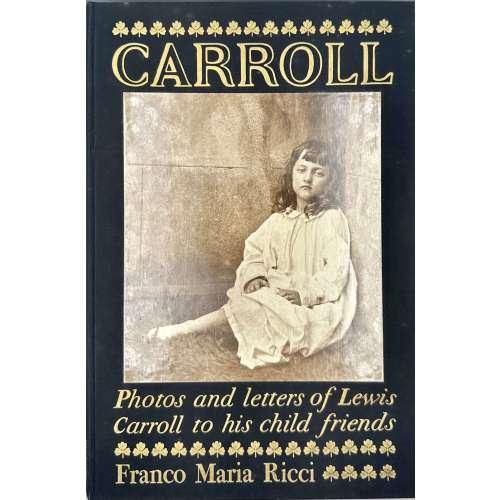 NEWHardcover volume, 355 x 240 mm, bound in black cloth with gilt lettering to front and spine with a photo portrait of Mary Millais (1860-1944), in a black cloth clam-shell box 370 x 253 x 40 mm, with a shamrock diaper black paper adorned with publisher’s coat of arms pasted to the front. Pp.: [1-12] 13-213 [3], with 41 glued-in photomechanically reproduced photographs, chiefly from the Gernsheim Collection at the University of Texas, two of them of Alice Liddell (pp. 123 and 127). Printed on hand-made blue laid paper. Edition is limited to 3,000 copies, of which this is copy № 1200. Title-page: Lewis Carroll | Photos and Letters | to His Child Friends | Edited by Guido Almansi | Notes by | Brassai and Helmut Gernsheim | Franco Maria Ricci | 1975 || Colophon: This volume was printed in Milan, Italy, in the month of November 1975, under the direction of Franco Maria Ricci. The hand-made paper is the work of the Pietro Miliani mills at Fabriano. This first edition consists of three thousand numbered copies. Copy n. [1200]. Facsimile. Seller’s description: Near Fine condition Hardcover Signed by Franco Maria Ricci on the colophon page, Numbered and Limited Edition #1200/3000 of copies. Includes Notes by Brassai and Helmut Gernsheim, with 41 tipped-in sepia-toned photographs, 213 pages. "The Signs of Man Volume 3". Black boards bound in Orient silk with gold engraved lettering on the spine and cover and a sepia-toned photograph affixed to the front cover, handmade Ingres pastel paper manufactured by Cartiere Milliani in Fabrianoo with decorated endpapers and deckled fore-edge. Housed in a black clamshell case with clover leaf pattern in Very Good + condition with the exception that there is no spine label and very light wear to the extremities. Oversize folio: 9" x 13 3/4" Contributors: Carroll, Lewis (British, 1832 – 1898) – Author/Photographer Ricci, Franco Maria (Italian, 1937 – 2020) – publisher Almansi, Guido (Italian, 1931 – 2001) – editor Brassai [Halász, Gyula] (Hungarian–French, 1899 – 1984) – notes Gernsheim, Helmut (Jewish-German, 1913 – 20 July 1995) – notes
NEWHardcover volume, 355 x 240 mm, bound in black cloth with gilt lettering to front and spine with a photo portrait of Mary Millais (1860-1944), in a black cloth clam-shell box 370 x 253 x 40 mm, with a shamrock diaper black paper adorned with publisher’s coat of arms pasted to the front. Pp.: [1-12] 13-213 [3], with 41 glued-in photomechanically reproduced photographs, chiefly from the Gernsheim Collection at the University of Texas, two of them of Alice Liddell (pp. 123 and 127). Printed on hand-made blue laid paper. Edition is limited to 3,000 copies, of which this is copy № 1200. Title-page: Lewis Carroll | Photos and Letters | to His Child Friends | Edited by Guido Almansi | Notes by | Brassai and Helmut Gernsheim | Franco Maria Ricci | 1975 || Colophon: This volume was printed in Milan, Italy, in the month of November 1975, under the direction of Franco Maria Ricci. The hand-made paper is the work of the Pietro Miliani mills at Fabriano. This first edition consists of three thousand numbered copies. Copy n. [1200]. Facsimile. Seller’s description: Near Fine condition Hardcover Signed by Franco Maria Ricci on the colophon page, Numbered and Limited Edition #1200/3000 of copies. Includes Notes by Brassai and Helmut Gernsheim, with 41 tipped-in sepia-toned photographs, 213 pages. "The Signs of Man Volume 3". Black boards bound in Orient silk with gold engraved lettering on the spine and cover and a sepia-toned photograph affixed to the front cover, handmade Ingres pastel paper manufactured by Cartiere Milliani in Fabrianoo with decorated endpapers and deckled fore-edge. Housed in a black clamshell case with clover leaf pattern in Very Good + condition with the exception that there is no spine label and very light wear to the extremities. Oversize folio: 9" x 13 3/4" Contributors: Carroll, Lewis (British, 1832 – 1898) – Author/Photographer Ricci, Franco Maria (Italian, 1937 – 2020) – publisher Almansi, Guido (Italian, 1931 – 2001) – editor Brassai [Halász, Gyula] (Hungarian–French, 1899 – 1984) – notes Gernsheim, Helmut (Jewish-German, 1913 – 20 July 1995) – notes -
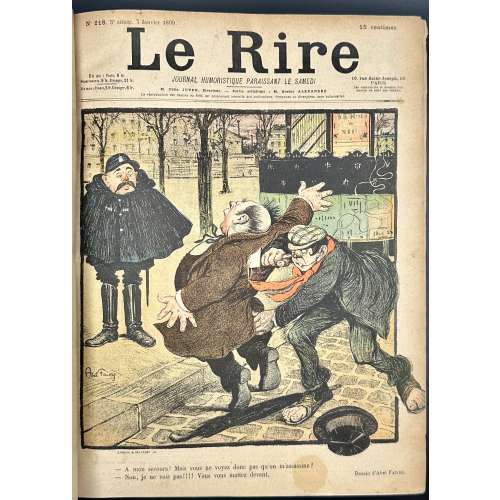 NEWLe Rire : journal humoristique hebdomadaire, 1899, 51 issues №№ 218-269 (lacking № 233 April 22nd), quarter bound by a contemporary owner in dark green faux morocco over marbled boards, marbled endpapers, gilt lettering to spine, 307 x 250 mm.Publisher: Félix Juven (French, 1862 – 1947) Printer: Bertin et Cie Artists: Jules Abel Faivre (French, 1867 – 1945) Lucien Marie François Métivet (French, 1863 – 1932) Charles Lucien Léandre (French, 862 – 1934) Jean-Louis Forain (French, 1852 – 1931) Jules Maurice Radiguet (French, 1866 – 1941) Louis-Christian Does [Döes, Doës] (French, 1859 – 1944) René Georges Hermann-Paul (French, 1864 – 1940) Caran d’Ache [Emmanuel Poiré] (French, 1858 – 1909) Charles Huard (French, 1874 – 1965) Benjamin Rabier (French, 1864 – 1939) Georges Meunier (French, 1869 – 1942) Pierre-Georges Jeanniot (Swiss-French, 1848 – 1934) Guydo [Joseph Robert Guillaume Le Barrois d'Orgeval] (French, 1868 – 1930) Henri [Henry] Gerbault (French, 1863 – 1930) Adolphe Willette (French, 1857 – 1926) Auguste Roubille (French, 1872 – 1955) Leonetto Cappiello (French, 1875 – 1942) Fernand Fau (French, 1858 – 1915) Georges Delaw [Deleau] (French, 1871 – 1938) Georges Tiret-Bognet (French, 1855 – 1935) Édouard Couturier (French, 1869 – 1903) Jean Villemot (French, 1880 – 1958) Guy Kadell (French, 18?? – 19??) Henri Louis Avelot (French, 1873 – 1935) Jan [Jean] Duch
NEWLe Rire : journal humoristique hebdomadaire, 1899, 51 issues №№ 218-269 (lacking № 233 April 22nd), quarter bound by a contemporary owner in dark green faux morocco over marbled boards, marbled endpapers, gilt lettering to spine, 307 x 250 mm.Publisher: Félix Juven (French, 1862 – 1947) Printer: Bertin et Cie Artists: Jules Abel Faivre (French, 1867 – 1945) Lucien Marie François Métivet (French, 1863 – 1932) Charles Lucien Léandre (French, 862 – 1934) Jean-Louis Forain (French, 1852 – 1931) Jules Maurice Radiguet (French, 1866 – 1941) Louis-Christian Does [Döes, Doës] (French, 1859 – 1944) René Georges Hermann-Paul (French, 1864 – 1940) Caran d’Ache [Emmanuel Poiré] (French, 1858 – 1909) Charles Huard (French, 1874 – 1965) Benjamin Rabier (French, 1864 – 1939) Georges Meunier (French, 1869 – 1942) Pierre-Georges Jeanniot (Swiss-French, 1848 – 1934) Guydo [Joseph Robert Guillaume Le Barrois d'Orgeval] (French, 1868 – 1930) Henri [Henry] Gerbault (French, 1863 – 1930) Adolphe Willette (French, 1857 – 1926) Auguste Roubille (French, 1872 – 1955) Leonetto Cappiello (French, 1875 – 1942) Fernand Fau (French, 1858 – 1915) Georges Delaw [Deleau] (French, 1871 – 1938) Georges Tiret-Bognet (French, 1855 – 1935) Édouard Couturier (French, 1869 – 1903) Jean Villemot (French, 1880 – 1958) Guy Kadell (French, 18?? – 19??) Henri Louis Avelot (French, 1873 – 1935) Jan [Jean] Duch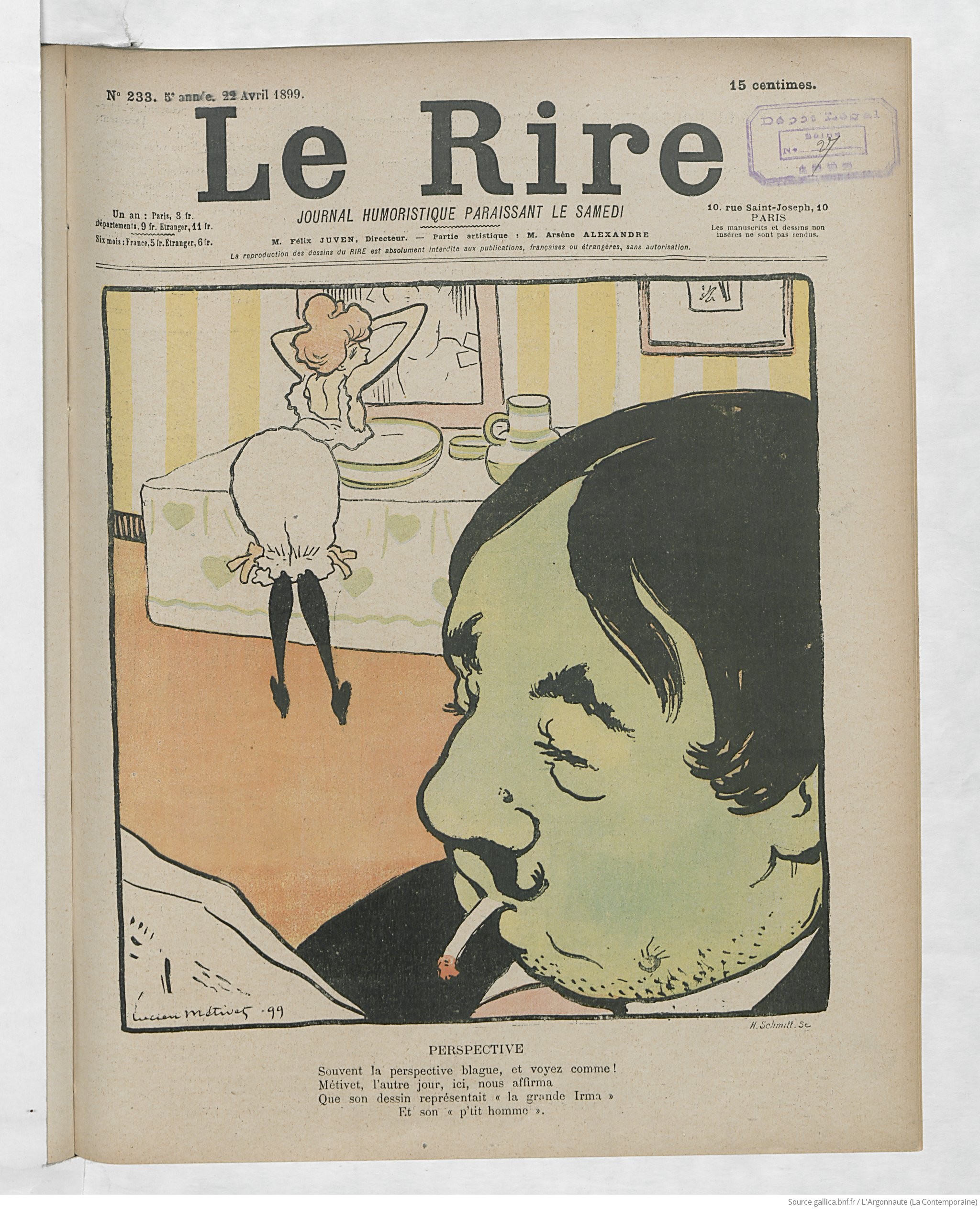
№ 233 April 22nd
-
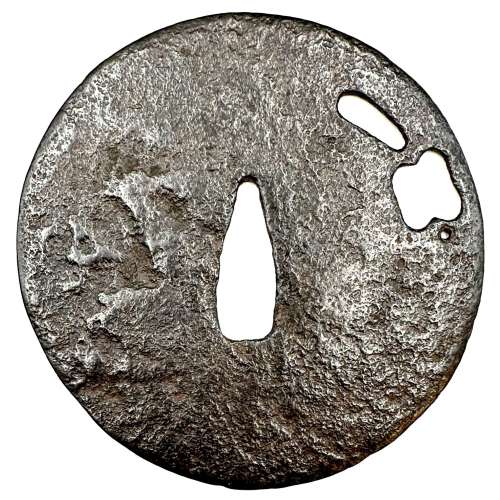 NEWThin plate iron tsuba of round form with a military commander's fan (gunbai) design in openwork (sukashi); Ko-tosho school. Kamakura period (1185 – 1333), 13th to early 14th century (according to Nakamura Tessei). Dimensions: 91.2 x 89.5 mm, thickness: 1.5-2.5 mm. Provenance: Patrick Liebermann Collection. Reproduced in the exhibition catalogue Samurai. Guerriers et esthètes, BNU, Strasbourg, March 11 – July 13, 2022, №045, p.91 and in Patrick Liebermann, Tsuba. Itinéraires d'une collection, 2016, №72, p.111. Reference: a similar tsuba reproduced in LIB-3304.2024 (see below) and in this collection TSU-0332.2017 (provenance Sasano Masayuki).
NEWThin plate iron tsuba of round form with a military commander's fan (gunbai) design in openwork (sukashi); Ko-tosho school. Kamakura period (1185 – 1333), 13th to early 14th century (according to Nakamura Tessei). Dimensions: 91.2 x 89.5 mm, thickness: 1.5-2.5 mm. Provenance: Patrick Liebermann Collection. Reproduced in the exhibition catalogue Samurai. Guerriers et esthètes, BNU, Strasbourg, March 11 – July 13, 2022, №045, p.91 and in Patrick Liebermann, Tsuba. Itinéraires d'une collection, 2016, №72, p.111. Reference: a similar tsuba reproduced in LIB-3304.2024 (see below) and in this collection TSU-0332.2017 (provenance Sasano Masayuki).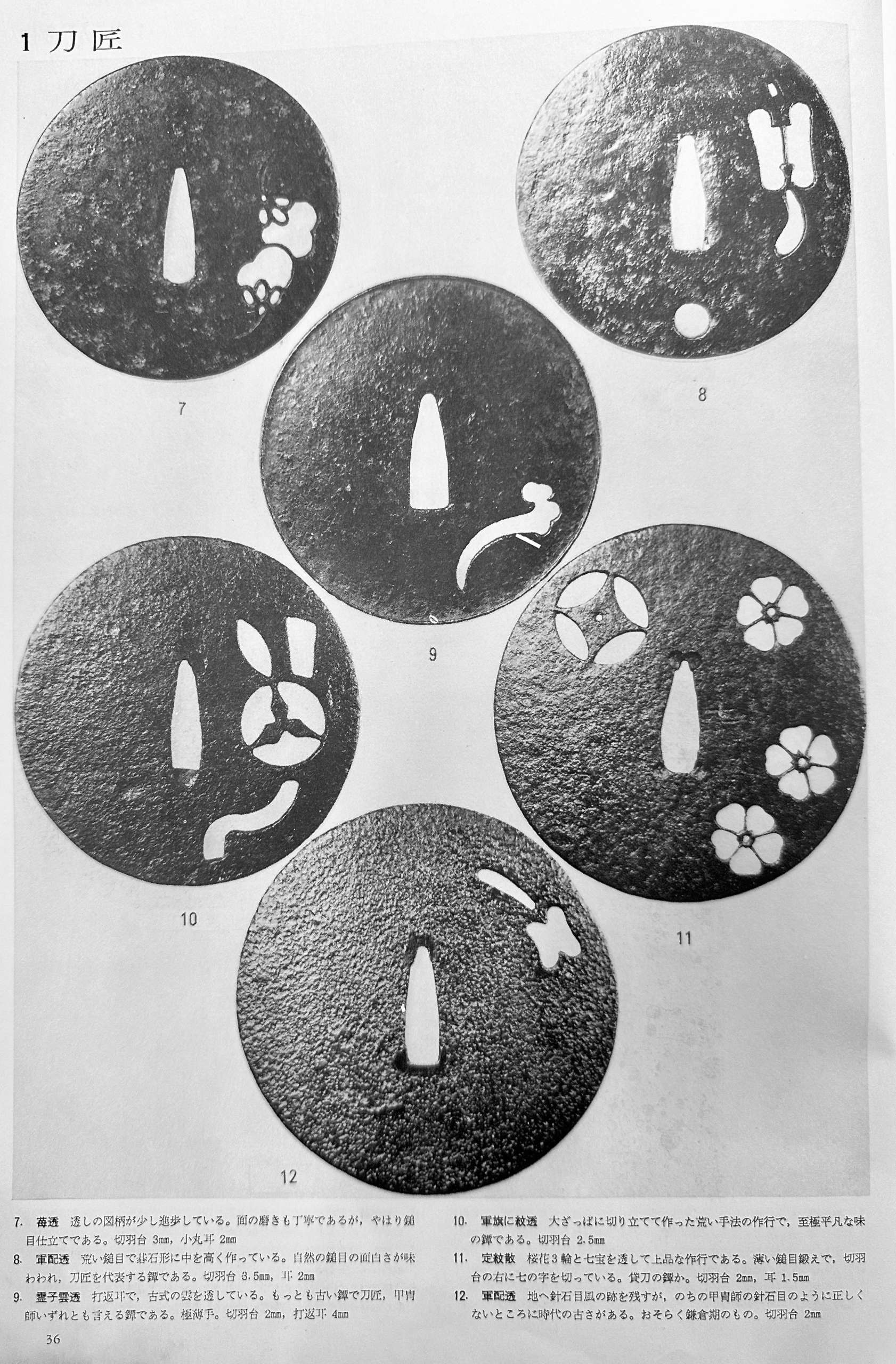
Tsuba Collection (Tsuba shūsei, 鐔集成) by Nakamura Tessei (中村鐵青), p.36, fig. 12.
-
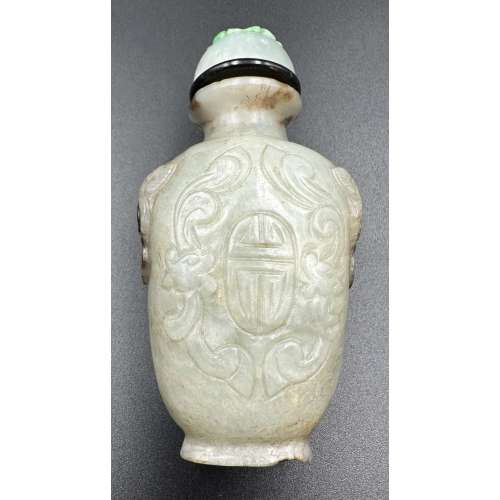 NEWJadeite snuff bottle carved with shou character and foo dog handles, with a black collar and jadeite stopper carved with a blossom design. Late 19th century. Dimensions: H74 x W39 x D26 mm
NEWJadeite snuff bottle carved with shou character and foo dog handles, with a black collar and jadeite stopper carved with a blossom design. Late 19th century. Dimensions: H74 x W39 x D26 mm -
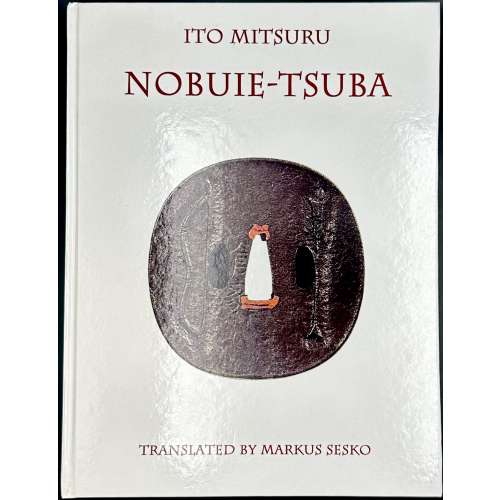 NEWHardcover, 280 x 121 mm, glossy white pictorial cover with mahogany lettering, pp. [1] 2-210 [2]. Lettering on the cover: ITŌ MITSURU | NOBUIE-TSUBA | {vignette} | TRANSLATED BY MARKUS SESKO || Title-page: Nobuie Tsuba | 信家鐔 | Itō Mitsuru (伊藤満) | translated by Markus Sesko | © 2016 Itō Mitsuru | Copyright translation: Markus Sesko | Print and Publishing: Lulu Press, Inc. ||
NEWHardcover, 280 x 121 mm, glossy white pictorial cover with mahogany lettering, pp. [1] 2-210 [2]. Lettering on the cover: ITŌ MITSURU | NOBUIE-TSUBA | {vignette} | TRANSLATED BY MARKUS SESKO || Title-page: Nobuie Tsuba | 信家鐔 | Itō Mitsuru (伊藤満) | translated by Markus Sesko | © 2016 Itō Mitsuru | Copyright translation: Markus Sesko | Print and Publishing: Lulu Press, Inc. || -
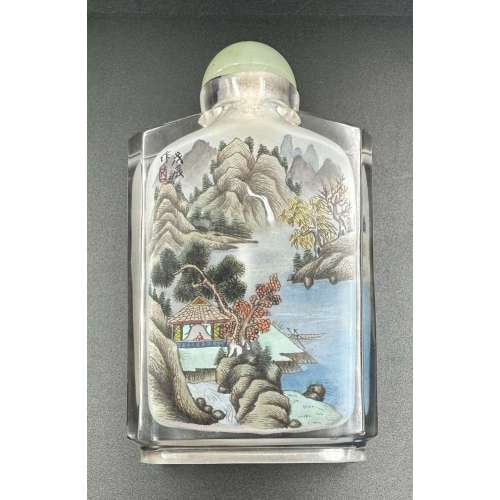 NEWLarge inside-painted glass snuff bottle with a mountain landscape design, signed and sealed Wu Chen Zuo, with a serpentine stopper. Mid-20th century. Dimensions: H105 x W61 x D27 mm.
NEWLarge inside-painted glass snuff bottle with a mountain landscape design, signed and sealed Wu Chen Zuo, with a serpentine stopper. Mid-20th century. Dimensions: H105 x W61 x D27 mm.


